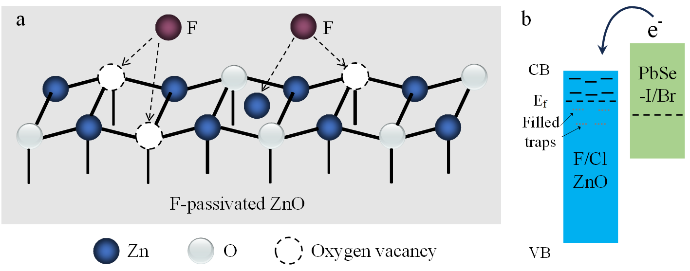The essential component of photovoltaic power generation is the pn junction. Electrons and holes can be transported to the positive and negative electrodes, respectively, by the electric field in the junction. The pn junction has the ability to transform photon power into electrical power and transfer this power to a load once it is linked to it and exposed to light.

(a) Schematic diagram of F-passivated ZnO. (b) Schematic band alignment diagram of F/Cl-passivated ZnO. Image Credit: Frontiers
For a very long time, this photovoltaic application has been utilized to power satellites and spacecraft as well as provide humans with clean, green energy.
Si, GaAs, and perovskite have become popular star materials for solar power harvesting. Nevertheless, these materials' absorption cutoff wavelength is less than 1100 nm, which restricts their use in infrared photovoltaic applications. Investigating novel materials for photovoltaics is, therefore, imperative.
Since PbSe colloidal quantum dots (CQDs) have a photoactive range that spans the entire solar spectrum, they are among the most promising materials for application in photovoltaics. The efficiency of PbSe CQD solar cells is getting close to 11.6% because of the quick development of metal halide ligands and the solution phase ligand exchange process.
In light of these advancements, the electron transport layer (ETL) and hole transport layer optimization (HTL) can be the main areas of attention for future device performance improvement (HTL).
Enhancing ETL is of interest to Prof. Kanghua Li at Huazhong University of Science and Technology (HUST), China, and Dr Jungang He at Wuhan Institute of Technology (WIT), China. A record-breaking PbSe CQD solar cell efficiency has already been reported.
They focused on the optimization of F-passivated ZnO to further increase performance with minimal changes to the device architecture. Since F ions’ radius is similar to that of oxygen ions, they are used for ZnO defect passivation. As a result, it is possible to reduce the ZnO trap density and increase device performance.
Journal Reference
He, J., et al. (2023) Fluoride passivation of ZnO electron transport layers for efficient PbSe colloidal quantum dot photovoltaics. Frontiers of Optoelectronics. doi:10.1007/s12200-023-00082-3
Source: https://www.frontiersin.org/